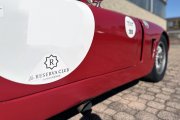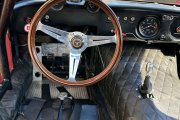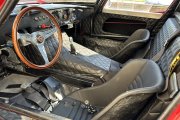ISO GRIFO A3/C 1964
- Period document in original plus current FIA HTP valid till 2027.
- Recognized car with important event palmares.
- Eligible for all the main historic events such as Le Mans Classic, Spa Six Hours, Tour Auto, Modena Cento Ore and others.
- Race ready for the incoming season.
Giotto Bizzarrini left Alfa Romeo in 1957 and went to Ferrari, which needed a test driver. He worked for five years at Ferrari as chief engineer and as a developer, designer and test driver. Quickly promoted to the position of development controller for experimental, sports and GT cars, the 3-litre V12 Testa Rossa engine, the 250 TR Testa Rossa and the 250GT SWB were largely influenced by his ideas and technical solutions. Bizzarrini would work hard to develop the chassis, engine and advanced dynamic solutions for the most legendary Ferrari racer, the 250 GTO.
In 1961, Bizzarrini was one of the "famous five" engineers who left Ferrari during the "night of the long knives", caused by a reorganisation of the technical staff. Together with other former Ferrari engineers (including Carlo Chiti), Bizzarrini founded the company Automobili Turismo e Sport (ATS) to build a Formula 1 single-seater and a GT sports car, the ATS Serenissima.
In 1962, Bizzarrini washired by Count Giovanni Volpi, owner of Scuderia Serenissima Republica di Venezia, to transform a Ferrari 250 GT SWB (chassis number 2819GT) into a GTO. Ferrari, in disagreement with Volpi, had refused to sell him a GTO and he was therefore forced to buy and modify a second-hand car. Bizzarrini and Piero Drogo of Carrozzeria Sports Cars in Modena developed an advanced aerodynamic bodywork, even lower than the GTO. This collaboration gave birth to the 250 GT Drogo 'Breadvan'.
In the same year, Bizzarrini founded the "Società Autostar", an engineering company through which he responded to tenders for independent engineering projects. Ferruccio Lamborghini will commission Società Autostar to design a V12 engine for the new GT cars of his company. The Lamborghini V12 was first fitted in 1964 to the 350GT, with variants of its basic architecture being used in all Lamborghini V12s until 2010. Società Autostar then developed cars for Iso Rivolta Autoveicoli S.p.A., starting from the Iso Rivolta IR 300 followed by the Iso Grifo and its racing version Iso Grifo A3/C. A dispute between Bizzarrini and Ing. Rivolta, owner of the firm, related to the racing units costs, ended their collaboration and led Società Autostar to continue the production of the Grifo A3/C under the Bizzarrini brand. Bizzarrini changed the name of Società Autostar first to "Società Prototipi Bizzarrini" in 1964 and then to "Bizzarrini SpA" in 1966.
The production planning phase of the Grifo A3/C provided to use the welded monocoque platform of the Iso Rivolta IR 300. The car adopted a front mid-engine, rear-wheel drive configuration and was powered by a Chevrolet 327 small-block engine with a displacement of 5.4L for 400 hp in the race version. The car accelerates from 0 to 100 km/h in less than 7 seconds and reaches a top speed of 280 km/h. The A3/C was equipped with Dunlop disc brakes, a BorgWarner T-10 four-speed manual gearbox. The first models used a de Dion rear suspension and a limited slip differential matched with an alluminium body work by Bertone, based on a design by Giorgetto Giugiaro, but the option of a lighter fibreglass body work matched with independent rear suspension was offered.
Chassis IR-35071 was delivered new as Iso GT IR 300 on 16 June 1964 in France, with plate 6077 KA 93. The car in 1988 changed owner and plate which became 5932 SZ 17.
Between 1989 and 1990 it was converted into Iso Grifo A3/C by Iso Rivolta dealer and service workshop Bardelli of Rome, utilizing the same procedure as made in period by the factory and fitting independent rear suspension and a fiberglass body.
The Iso Grifo A3/C was acquired by the present owner in 2008, in bad condition but complete of all the original Bizzarrini parts such as magnesium competition oil cup, Weber carburettors, exhaust and others. It was submitted to a complete restoration, according to racing specification, made by Ebimotors Classic under the supervision of Carlo Facetti.
The car was invited, in 2022, to a celebration of Giotto Bizzarrini in his town Livorno, and during this event, it was inspected and signed by Giotto Bizzarrini himself and by the team of engineers and technicians of period including Stefano Volpi and chief of the racing division.
The car has its engine correct as period numbered GM 3782870 and completely rebuilt in February 2021 while the gearbox has 1 hour of test only. It is ready for the incoming season.
It has a current FIA HTP valid up to 2027 and the “French grey car” of period in original (expired).
It raced in several races of Peter Auto GT Trophy in Paul Ricard, Dijon, Monza.
It is eligible for Peter Auto’s Greatest Trophy, Sixties Endurance, Le Mans Classic and Spa Six Hours.
It has been invited to the 2019 Concours d’Elegance at Chantilly and 2017/2018 Vernasca Silverflag and it was awarded “Best of Show” at Cesana - Sestriere Experience in 2022.
P.O.A.



























